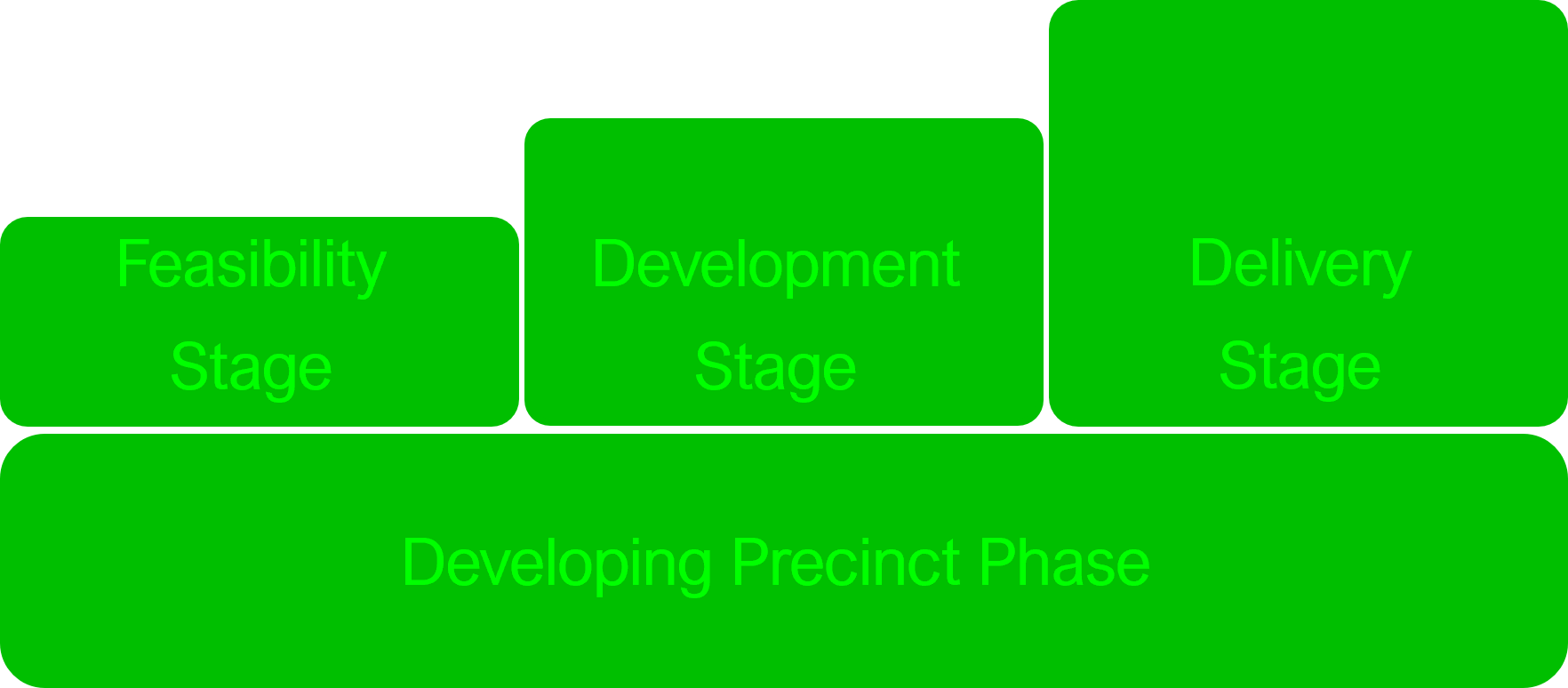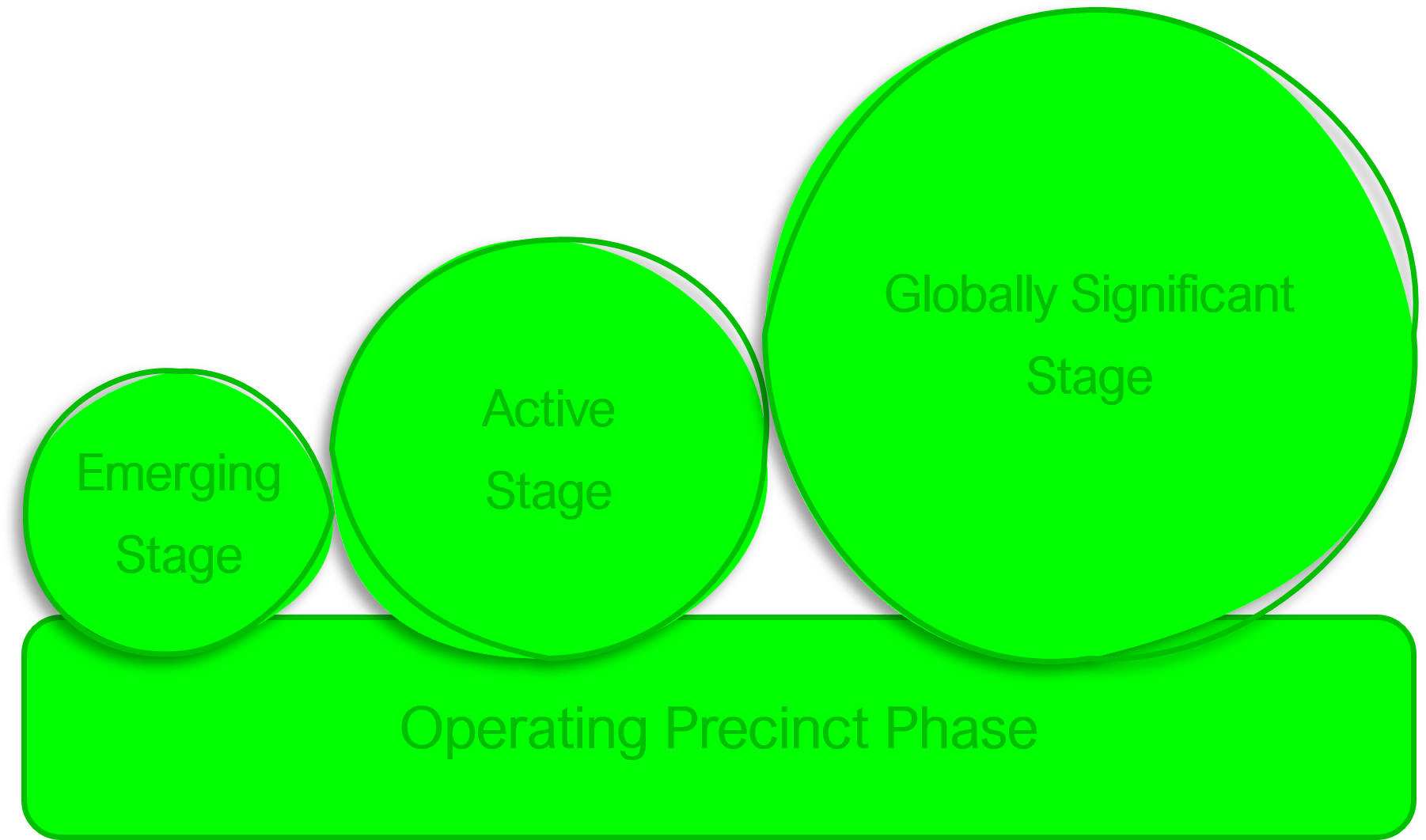Precinct Maturity Roadmap
Site Navigation:

Two Phases + Six Stages
Without a common fundamental understanding we are unable to benchmark expectations and communicate clearly.
Precincts are never static, always changing and evolving. They are places where life happens, and commerce occurs. They can build community and drive economy. The dynamic nature of precincts is also reflected in the important relationships between community, industry, and Government working together.
The Precinct Maturity Roadmap is a guide for the standardisation of the stages that a precinct may be in at one time or another. This enables us to clearly communicate about a precinct, and provide a roadmap for best practice precinct governance along the maturity lifecycle. Standardising precinct maturity is similar to standardised business and project maturity lifecycles.
The precinct maturity roadmap also overlays precinct governance thinking. Each stage description includes a lookout for individual elements along the roadmap.
A precinct is never static.
The precinct maturity roadmap enables a common language (e.g. this is an active precinct, whereas that one is in development.) Some precincts commence as property developments, with the intention of an operating precinct at completion. Some precincts are existing neighbourhoods whose constituents come together and formalise a precinct.
As precincts mature so too must their governance. A governance model focussed on attracting investment for a new development is very different to an active precinct focused on increased visitation. Enabling a common maturity language allows us to differentiate the best practice elements for success.
-
The development phase is the development of the built environment. A precinct property development is a large multi-stage development of infrastructure, buildings, and public open space. It requires the act of preparing a geographically bound aggregation of land, under a single precinct development strategy, with the intent of an operating precinct following occupation of the site. This can be on greenfield or brownfield land.
The difference between a conventional property development and precinct development is that a precinct has a higher level of collaboration between actors for a longer timeline. There is also a greater promise of economic benefit.
The precinct governance requirements will therefore typically involve multiple key actors beyond the developer, such as universities, anchor tenants, utilities, and multiple Government departments (e.g. planning, treasury, transport.)Importantly, not all precinct developments will transition into a meaningful operating phase. When a large development is marketed as a precinct, but the land is sold or leased as independent lots with minimal shared obligations, then there is minimal governance required during the operating phase.
A precinct development with minimal governance does not benefit from the multiplier effect of stakeholders working together. Notwithstanding, constituents of the precinct development may still choose to self-organise their precinct. Self-organisation is an example of a precinct occurring after the development phase. -
The feasibility phase is a chaotic time of uncertainty that’s objective is to achieve an alignment on stakeholder vision, objectives, and governance. This phase is the most influential for adopting current best practice from lessons learned and innovative approaches.
Seven key factors for effective precinct governance[1]:
Co-design and co-invest for effective governance
Identify the right degree of independence
Allow diversity of voice and view
Strategically involve government based on local conditions
Tie governance to land
Design a financially sustainable model
Ensure flexibility—a governance model that can adapt over time
During this phase the effort is distributed into:
Stakeholder engagement
Political networking
Establishing governance framework
Creation of strategic artefacts
Defining value
Justifying need
This effort is culminated into a strategic framing plan for a precinct business case that will be reviewed by all key stakeholders before a precinct is formally agreed. This brings with it the management plan, investment profile and benefits realisation plan.
[1]Why Governance Matters: An analysis on how innovation districts “Organize for Success”, June 2023, The Global Institute on Innovation Districts
-
During this phase the effort is distributed into:
Value management
Refining and communicating the detail of the opportunities
Dividing the site into development sites and obtaining planning approvals
Collecting and analysing site, industry, financing data
Establishing the delivery and operations revenue sources
Growing the value proposition through a marketing strategy
A series of large transactions
Development partners
Funding agreements
Construction delivery
Anchor tenant lease agreements
Always ensuring ethical behaviour by all participants is maintained and can be proven to protect precinct value.
The Development phase will likely be structured into a series of delivery stages with staggered start dates. Therefore, there is an important overlap between the development and delivery that occurs once the first delivery agreement is signed. The overlap will extend from development, and delivery, to operations phase when Stage 1 is occupied. Therefore, there is augmentation to the Sponsor and Management responsibilities, skills, and interests that causes dynamic changes to the precinct organisational control and personnel.
Investment assurance activities are in place to guide investment major decision making by the sponsor.
-
Delivery contracts can be either direct contracts for construction or development partnerships with 3rd parties that will eventually construct. Either way, the sponsor and management team transition their focus from value creation to the performance of others realising value against baseline expectations.
The most significant capital expenditures occur in the delivery phase. This requires the highest level of proactive expert involvement to ensure good delivery, and the best systems to track quality against expenditure.
Investment assurance activities are in place for objective views on delivery performance that may require interventions to protect investments.
-
The operating phase is the time when the long term benefits of precincts are realised. Regardless of how a precinct comes into being, the operations phase is the manifestation of a group of people working together so that their mutual effort benefits their individual endeavours.
Successful operating precincts are run through good governance in the same way as Local, State, and Federal Government operate. Each jurisdiction has unique obligations to manage on behalf of their constituents.
A precinct does not duplicate or replace Government obligations. The precinct obligations are the purpose of that precinct, and the focus of the precinct governance body. These obligations are set by the precinct constituents and may generically include, but not limited to:Marketing of the precinct, its brand, and its constituents
Event management for constituents and/or visitors around the precinct purpose
Additional property security
Additional cleaning and maintenance to higher standard
Additional social, transport, or economic infrastructure
Data capture, analytics, and best practice research
Community advocacy to Government
-
Emerging precincts originate in two ways:
Property development (refer to Table 1 for Precinct Development stages), or
Self-organised
An emerging precinct from a property development will have new properties and new businesses. The precinct organisation would have been compulsory for the new owners/tenants. The precinct governance will have been created by the property developer.
A self-organised precinct will have existing businesses in existing properties. The precinct governance is developed by those businesses as a means to work stronger together. Importantly, not all constituents within the precinct may have agreed to be part of the precinct at commencement.
Sustainable precinct operation quality is directly attributed to the continuity of funding. Emerging precincts from property developments offer the opportunity for unique long term funding streams directly linked to incentivising value improvement (i.e. value capture, precinct levies.) Whereas self-organised precincts are more difficult to establish funding arrangements.
An emerging precinct is focussed on:
Establishing governance
Adopting a vision and brand
Expanding awareness
Increasing participation
Demonstrating value
-
An active precinct is a going concern that benefits Country. It has proven to be valuable and will continue indefinitely. An active precinct is a known brand identity and aspires to increase its vibrancy for its community, residents, visitors and workers by curating experiences.
Once a precinct has emerged from its nascent state, and tested its operations, its precinct governance is formalised. The structure, cadence, and processes for decision making are now commonly understood and are documented in organisational artefacts.
The governance group(s) of an active precinct respond to the needs of the precinct. The maturity of operations may have determined additional governance forums were necessary to improve the effective dissemination of information for the Executive Committee’s decision making. These additional forums might include Government and Community, Strategy, Data Analytics, Security, and Event Management.
The culture of the constituents is collaborative and entrepreneurial in an active precinct. New partnerships are formed leveraging the precinct relationships and brand. Visitation is steady and increasing due to good enabling infrastructure and event management. The value of the retail and office space is strong.
An active precinct has achieved sustainable funding from a combination of levies, grants, and various revenue collection opportunities (e.g. events, parking).
-
A globally significant precinct has achieved a state where demand is far greater than supply due to global recognition. The precinct is established, sophisticated and proven. The precincts economic contribution is vital to other forms of Government.
Precinct governance of a globally significant precinct will have a strong culture of transparent decision making to support the active leadership and influence on major investment decisions by itself, its businesses, and jurisdictional Governments. The curatorial mindset is embedded in the governance support networks to proactively move with the times.
As a respected global brand identity its funding will have substantial investment sources and expectations of sustained market presence.




